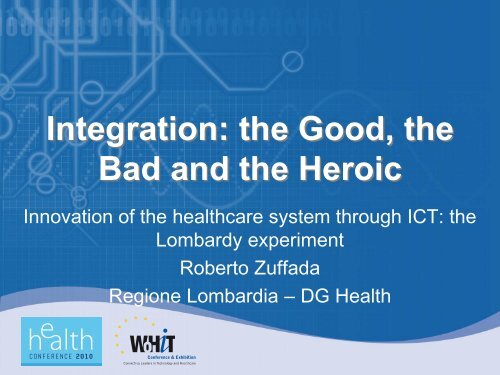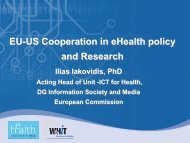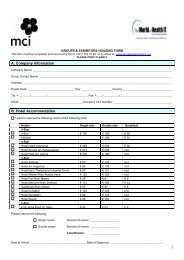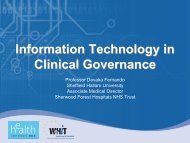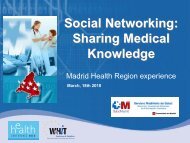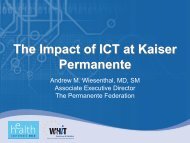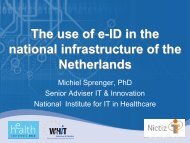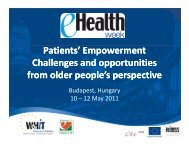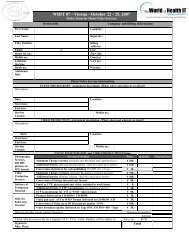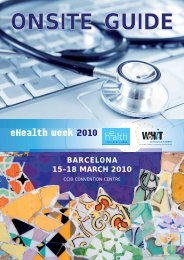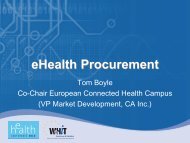The Lombardy Experiment
The Lombardy Experiment
The Lombardy Experiment
- No tags were found...
Create successful ePaper yourself
Turn your PDF publications into a flip-book with our unique Google optimized e-Paper software.
eHealth strategy up to 2010: theCRS-SISS projectHealth and Social Services IT System (SISS)• ICT tools and systems to improve and rationalise healthcare processes (Technological, Organisational,Financial/Budget)• Smart card based technologies ensuring secureaccess to the healthcare network both to citizens andprofessionals• Improvement of healthcare services, better and moretargeted planning of the Regional Health System,and integration of the healthcare services with ICT
eHealth strategy up to 2010: theCRS-SISS projectHealth and Social Services IT System (SISS)• Providing professionals with tailored patientinformation through a unique access point• Introducing innovation in the hospitals’ ICT systems,including customisation of their IT architecture for theintegration with the SISS system, and organisationalchanges in day-by-day work
eHealth strategy up to 2010: theSISS services• Citizen Identification: Regional General Registry andCitizen Card• e-Prescriptions Management• Electronic Health Record (EHR): sharing clinical dataamong HC Professionals (events, prescriptions, reports,care profile, …), enabling on-line access for citizens• Booking and Payment Services for citizens byInternet, GP, Pharmacies• Regional Call Centre, to improve citizen’s access toHC services
eHealth strategy up to 2010: theSISS services• Digitalization of all medical and administrativedocuments in order to improve efficiency andeffectiveness of processes• Accounting information management flow• Security Services: Identification & Authorisation- <strong>The</strong> security and confidentiality principles of SISS are thefollowing:- Citizen consent to processing their health data, inaccordance to Art. 29- Identification and authorisation of users- Data security- Limited access
eHealth strategy up to 2010: theSISS documents<strong>The</strong> SISS network allows for the gathering andorganisation of documents for clinical purposes. Allcitizens registered in the Regional General Registry have acitizen card and an EHR.<strong>The</strong> information can be accessed by all healthcareprofessionals and administrators connected to SISS,provided appropriate identification and the citizen’s explicitconsent. SISS contains metadata that points to the synthesisreports of all healthcare events
eHealth strategy up to 2010: theSISS documents<strong>The</strong> following EHR documents can be accessed via SISS,independent of the location of the point of care:• Drug prescriptions• Vaccination records• Test results• Hospital discharge letters• <strong>The</strong>rapeutic plans• Referral letters• Emergency Services reports.
CRS-SISS implementation• Distributed citizens cards: 9.740.000 (100%) (including reissuing)• Citizens joining SISS: 4.960.000 (54%)• HCPs with professionals cards SISS: 63.000 (76%) (publicsector)• SISS work stations: 26.100 (public sector)• GPs joining SISS: 7.167 (92%)• Pharmacies connected to the SISS network: 2.593 (100%)• Public hospitals joining SISS: 112 (100%)• Local Healthcare Units joining SISS: 15 (100%)• Private healthcare organisations connected to SISS: 355(96%)
CRS-SISS implementation / EHR• Monthly contacts: 1.590.000• ePrescription – pharmacies (monthly): 4.200.000 (80%)• ePrescription – laboratories (monthly): 1.600.000 (58%)• Lab medical reports (monthly): 490.000 (88%)• Radiology medical reports(monthly): 140.000 (73%)• First aid medical reports (monthly): 172.000 (70%)• Discharge letters (monthly): 58.500 (49%)
CRS-SISS implementation• Timeline of SISS developmentFunctionality / ServiceStart Date(First issue/ServiceActivation)Estimation of theStatus of work inAug-2009(deployment)Finish Date(Full deploymentand/ordistribution)eBooking Before 2002 70% 2010Digital Signature:Electronic Cards and ClientPeripherals;2002 90% 2010Source: “Report on<strong>The</strong> socio-economic impactof the health informationplatform Sistema SISS in theregion of <strong>Lombardy</strong>, Italy”empirica-TanJent, 2009Digital Signature:Infrastructure2002 100% 2008Clinical applications:Ambulatory reports 2006 70% 2010Lab reports 2006 95% 2010Radiology reports 2006 92% 2010A&E 2006 88% 2010Discharge letters 2006 88% 2010Managing Prescribing 2006 100% 2009ePrescribing of drugs 2006 88% 2010
CRS-SISS implementation• Pathology networks creationA new development is the establishment of pathologynetworks with the aim of utilising the opportunities provided bySISS for continuous and ubiquitous care for those who need it.Currently, there are 3 active pathology networks, for- Oncology- Epilepsy and- Rare pathologiesAnother 5 networks, covering cardio-vascular and strokediseases, dialysis, hearing, and the phenomenon of infantsdeath, are in the process of being implemented.
CRS-SISS implementation• Pathology networks creationA hospital is appointed to define the content standards andstructures of the documents for the respective network.Pathology networks already exchange documents that arebased on structured data, and for future documents sharedin SISS are envisaged to consist of structured data.
eHealth strategy towards 2020• <strong>The</strong> scale and complexity of the SISS initiative requiresvery careful planning and gradual implementation.• <strong>The</strong> functionalities already in place generate arespectable socio-economic return.• Legislation has a direct impact on deployment offunctionalities and benefit realisation.• <strong>The</strong> future potential of SISS lies in integration of HPOsnot yet part of the network, which are mainly privatesector providers, and expansion of functionalities to allhealthcare services.Source: “Report on<strong>The</strong> socio-economic impact of thehealth information platform SistemaSISS in the region of <strong>Lombardy</strong>, Italy”empirica-TanJent, 2009
eHealth strategy towards 2020• <strong>The</strong> provision of medical information from as manyhealthcare services and facilities as possible increasesthe extent of benefits, especially regarding patientsafety. This, in turn increases the necessity forhealthcare professionals, both in GP practices andhospitals, to actively integrate information sharing intotheir clinical routine.• <strong>The</strong> pathology networks already active of in the processof establishment will both foster continuity of care andimpact health professionals’ attitude towards thenecessity of data exchange without local restrictions.Source: “Report on<strong>The</strong> socio-economic impact of thehealth information platform SistemaSISS in the region of <strong>Lombardy</strong>, Italy”empirica-TanJent, 2009
eHealth strategy towards 2020• <strong>The</strong> main drivers for benefits are data sharing andeBooking functionalities.• Data sharing• renders safer healthcare provision, especially in cases wherepatients would otherwise not bring their referrals or dischargeletters;• it allows for data validation and counter-checking of test results, forpreparation of consultations in advance, for the creation of newhealthcare models, and time savings and increased productivity.• eBooking• fosters HPOs’ resource planning and allocation,• saves time and travel costs and• makes scheduling much more convenient for patients.
Integration: the Good, theBad and the HeroicInnovation of the healthcare system through ICT: the<strong>Lombardy</strong> experimentRoberto ZuffadaRegione Lombardia – DG Health


